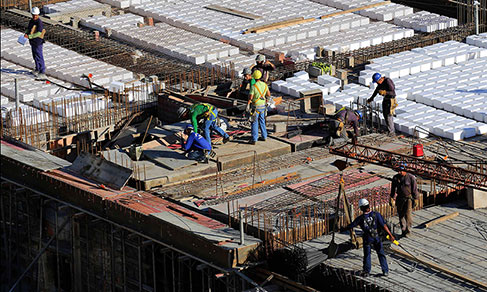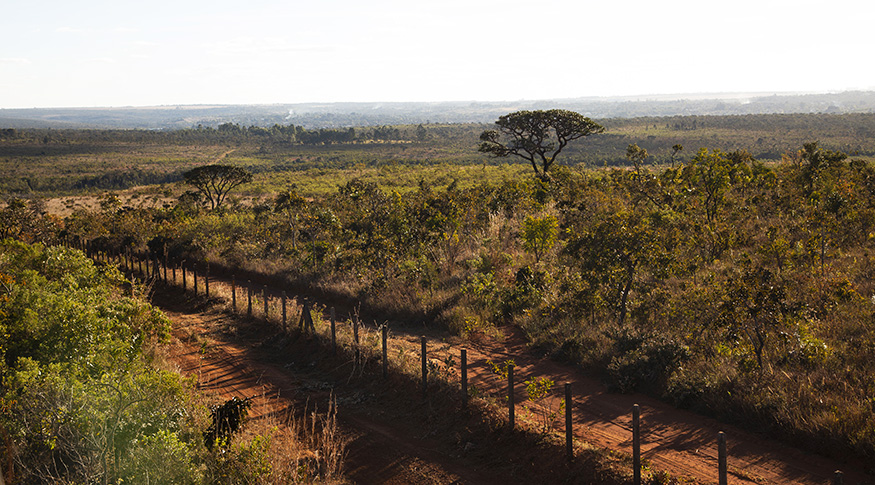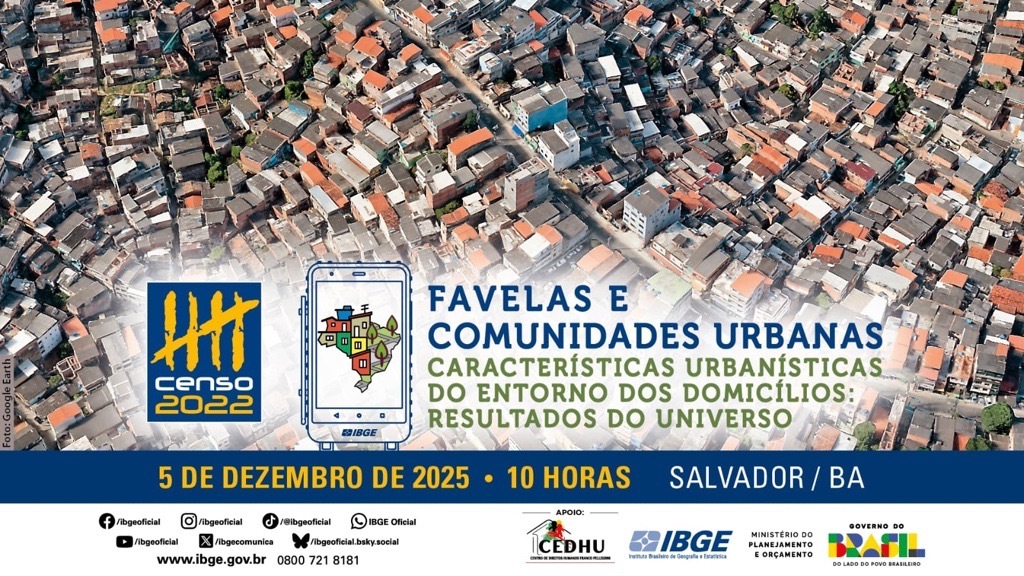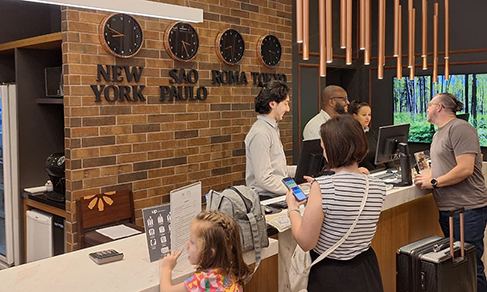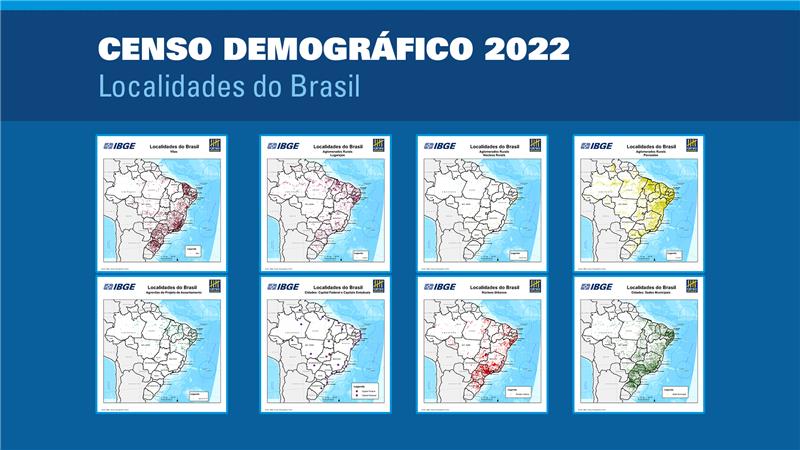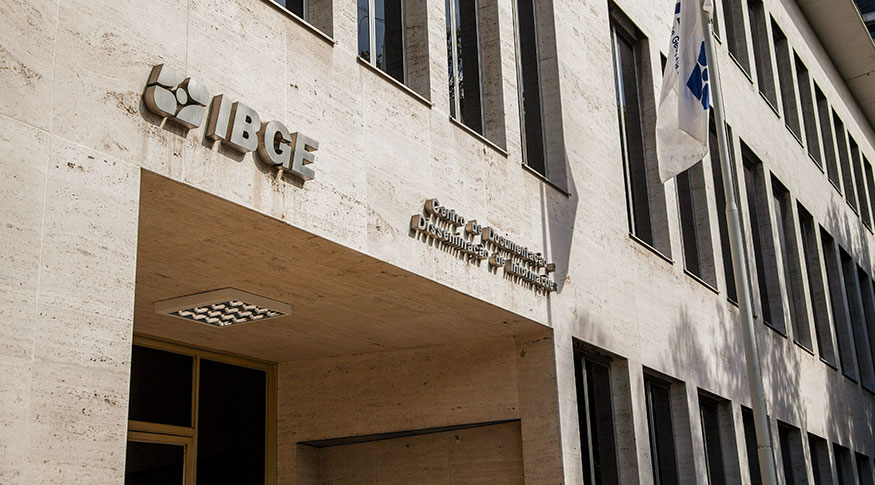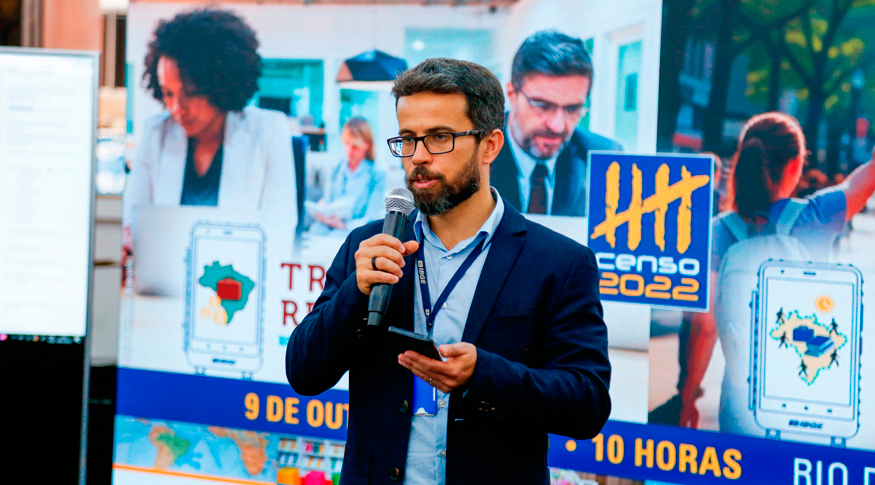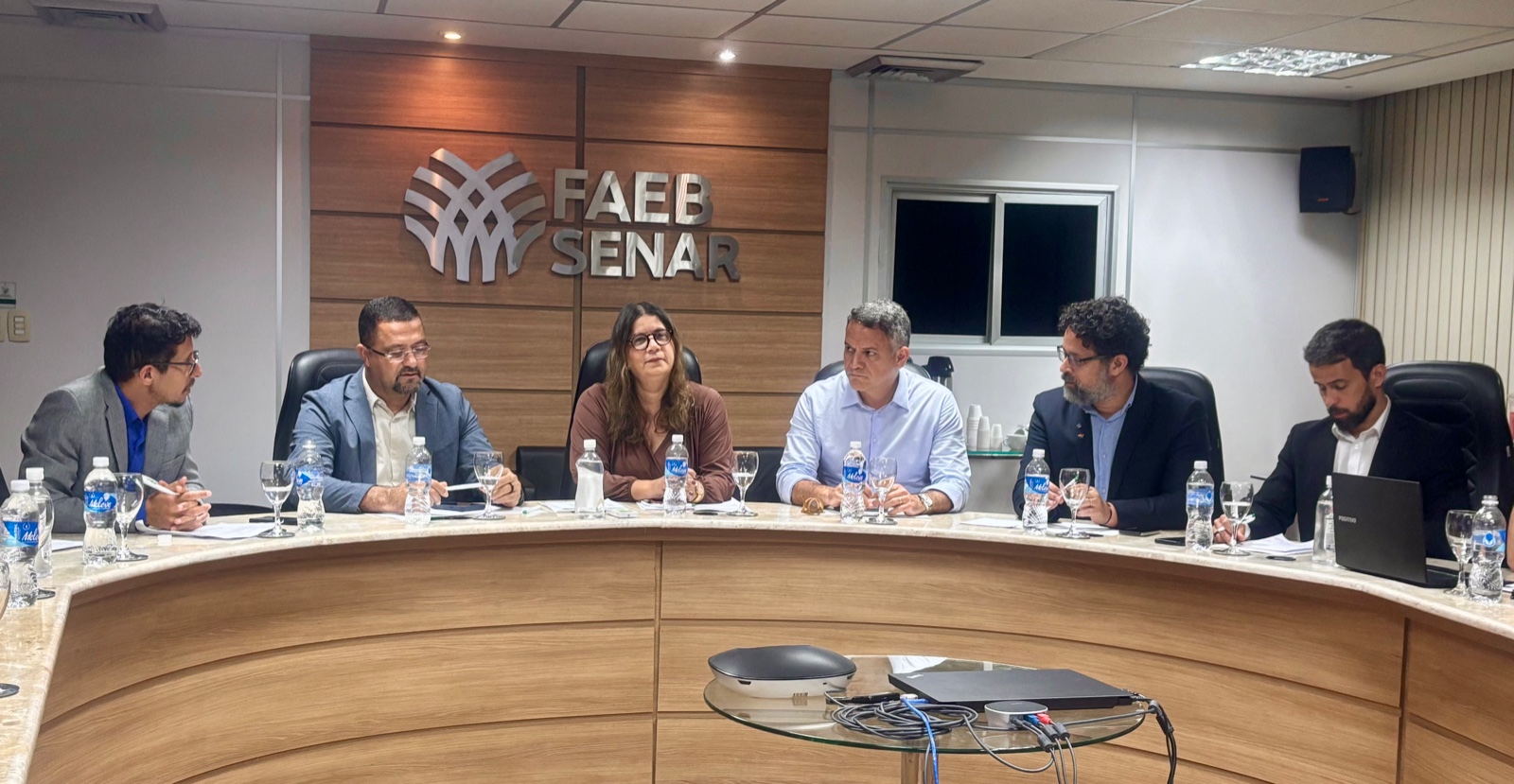2022 Census
2022 Census: Catholics remain in decline; protestants and persons with no religion increase in the country
June 06, 2025 10h00 AM | Last Updated: June 09, 2025 01h30 AM
Highlights
- From 2010 to 2022, according to data from the population Census, there was a drop in the percentage of Roman Catholics (56.7%) and an increase in that of protestants (26.9%) and of persons with no religion (9.3%). In 2010, Catholics were 65.1% of the population aged 10 and over, protestants were 21.6%, whereas persons with no religion corresponded to 7.9% of the informants.
- Among Catholics, there was a decrease of 8.4 percentage points (p.p.) from 2010. The proportion of protestants and of persons with no religion, in turn, increased 5.2 p.p. and 1,4 p.p., respectively.
- Spiritualism (1.8%) dropped 0.3 p.p. against 2010 (2.2%). Umbanda and candomblé, on the other hand, went from 0.3% in 2010 to 1.0% in 2022, an increase of 0.7 p.p.
- In 2022, Catholicism led in all the Major Regions in the country, being mostly concentrated in the Northeast (63.9%) and in the South (62.4%). A bigger proportion of Protentants was found in the North (36.8%) and in the Central West (31.4%).
- The biggest concentration of self-declared spiritists was found in the Southeast (2.7%), and candomble and umbanda practicioners were more often found in the South (1.6%) and in the Southeast (1.4%). The Southeast (10.5%) also has the biggest number of persons with no religion.
- Although Roman Catholics were the majority in all the age groups, the proportion of this group changed between 52.0%, in the group aged 10 to 14, to 72.0% among persons aged 80 and over.
- In 2022, Catholicism was predominant in all the categories of color or race, having reached 60.2% among white persons. Indigenous persons had the biggest proportion of protestants (32.2%). The biggest proportions of spiritualists (3.2%), and persons with other religions (13,6%) and with no religion (16.2%) were found among Asians.
- Indigenous religions (24.6%) and Roman Catholics (7.8%) were the religions groups with the highest illiteracy rates of personsaged 15 and over. The religious groups with the lowest illiteracy rates were spiritists (1.0%) and umbanda/candomble practicioners (2.4%).
- In 2022, spiritists were the ones with the lowest percentage of persons without schooling and with incomplete primary education (11.3%), and the highest percentage of persons with a higher education degree (48.0%).
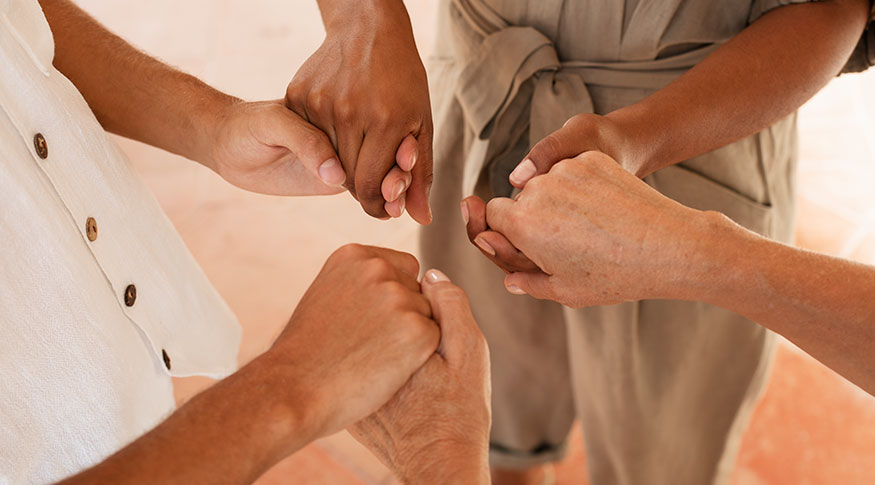
The 2022 Population Census showed the consolidation of changes in the geogrpahic profile of Brazil. Roman Catholicism, which concentrated 65.1% (105.4 million) of the population aged 10 and over in 2010, amounted to 56.7% (100.2 million) in 2022, a drop of 8.4 percentage points (p.p.). On the other hand, there was an increase of 5.2 p.p. in the proportion of protestants, with a change from 21.6% in 2010 (35 million) to 26.9% in 2022 (47.4 million). Data are found in 2022 Population Census: Religions: Preliminary sample results, released today (06) by the IBGE. The release event started at 10 am, at Casa Brasil IBGE, located on the first floor of Palácio da Fazenda (RJ), streamed online on Digital IBGE.
The proportion of persons who declared having no religion increased by 1.3 p.p. between 2010 and 2022, having changed from 7.9% to 9.3%. The religions umbanda and candomblé (from 0.3 % in 2010 to 1.0%, in 2022) and other religions experiences (from 2.7% to 4.0%). There was a slight decreasse in spititualism (from 2.2% to 1.8%). Indigenous religions made up 0.1% of the reports.
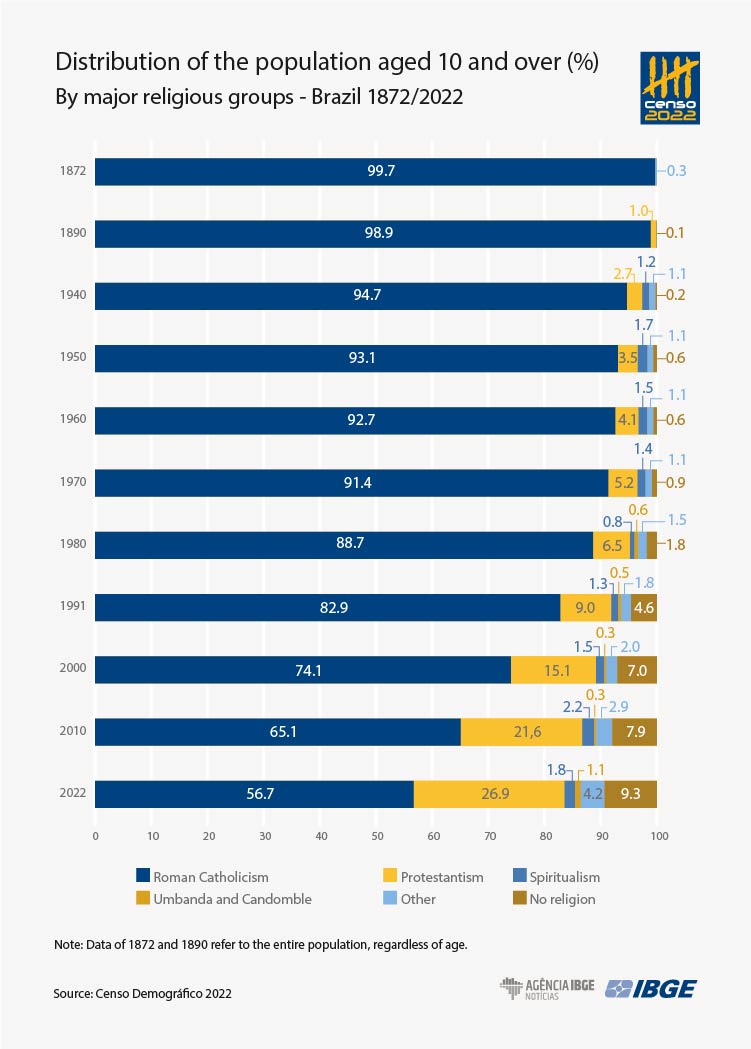
“In 150 of religion censuses, a lot has changed in the country and in society as a whole,” says the analyst in charge of this yopic, Maria Goreth Santos, as she mentions the first Census. “In 1872, the enumerator used to classify each informant as ‘cathólico’ (Catholic) or ‘acathólico’ (non-Catholic), according to the spelling in effect at the time; there was no other option for one's religion." Also, all the slave population was counted as Catholic, following orders by their lord."
Today, information on religion in Brazil encompasses varied groups and subgroups. “The social changes have resulted in changes in the methodology throughout these decades. Codes, a classification structure and incorporation of religious declarations gradually became necessary to portray religious diversity in Brazil in the most trustworthy way possible,” Maria Goreth states.
Catholicism was the predominant religion in the country, having its biggest concentration in the Northeast (63.9%), followed by the South Region (62.4%), and the lowest proportion in the North Region (50.5%). Protestants ranges between 36.8%, in the North Region, and 22.5%, in the Northeast. The biggest proportion of self-delcared Spiritists were in the Southeast region, with 2.7%; as for Umbanda and Candomble practicioners, they were in the the South (1.6%) and Southeast (1.4%). Persons with no religion were mostly found in the Southeast Region, with 10.5 %, where there is also a high proportion of other religions (4.9%).
Among the 27 Federation Units, 13 have a proportion of Roman Catholics above the national average (56.7%), in the population aged 10 and over. The biggest proportion was registered in Piauí (77.4%), which is also the state with the lowest percentage of Protestants (15,6%). Roraima (37.9%), Rio de Janeiro (38.9) and Acre (38.9%) had rhe lowest proportions of Roman Catholics.
As for Protestants, the biggest proportion was registered in Acre (44,4%), and the smallest, in Piauí (15.6%). The biggest proportion of Spiritists was found in Rio de Janeiro (3,5%), whereas the biggest proportion of Umbanda and Candomblé practicioners was in Rio Grande do Sul (3,2%) – both positions had been registered in 2010. Roraima had the biggest proportion of persons with no religion (16.9%), of other religions (7.8%) and followers of Indigenous traditions (1.7%).
Persons with no religion are 9.3% of Brazilian; most of them are men
The 2022 Census showed that the population with no religion was on an upward trend, with a change from 7.9% in 2010, to 9.3% in 2022, having reached 16.4 million in the last Census. Most of them were men, a total of 56.2% or 9.2 million persons aged 10 and over.
The Southeast Region, with 10.6% of its population listed as having no religion, was the only proportion above the average in the country, representing 7.9 million persons. The smallest proportion was in the South Region, 7.1%.
In terms of Federation Units, the biggest proportions of persons with no religion were in Roraima and Rio de Janeiro (both with 16.9%); the smallest proportions were in Piauí (4.3%), Ceará (5.3%) and Minas Gerais (5.7%).
Protestants have a younger profile
Although Roman Catholics are the majority in all the age groups, their proportion changed between 52.0%, in the group aged 10 to 14, to 72.0%, in the group aged 80 and over. Among Protestants, there is a reversed relationship: the biggest proportion (31.6%) is in the younger group, aged 10 to 14, and thoses aged 80 and over represented the lowest proportion, 19.0%. Those with no religion reached their maximum proportion in the group aged 20 to 24 anos (14.3%) and the minimum, in the population aged 80 and over (4.1%).
In the disaggregation of the population by color or race, the 2022 Census revealed that, among white persons, 60.2% saw themselves as Roman Catholic, 23.5% as Protestants and 8.4%, as followers of no religion. Indigenous persons had the biggest proportion of Protestants (32.2%), whereas Asians, the lowest (14.3%). The biggest proportions of Spiritists (3.2%), followers of other religions (13.6%) and persons with no religion (16.2%) were found among Asians.
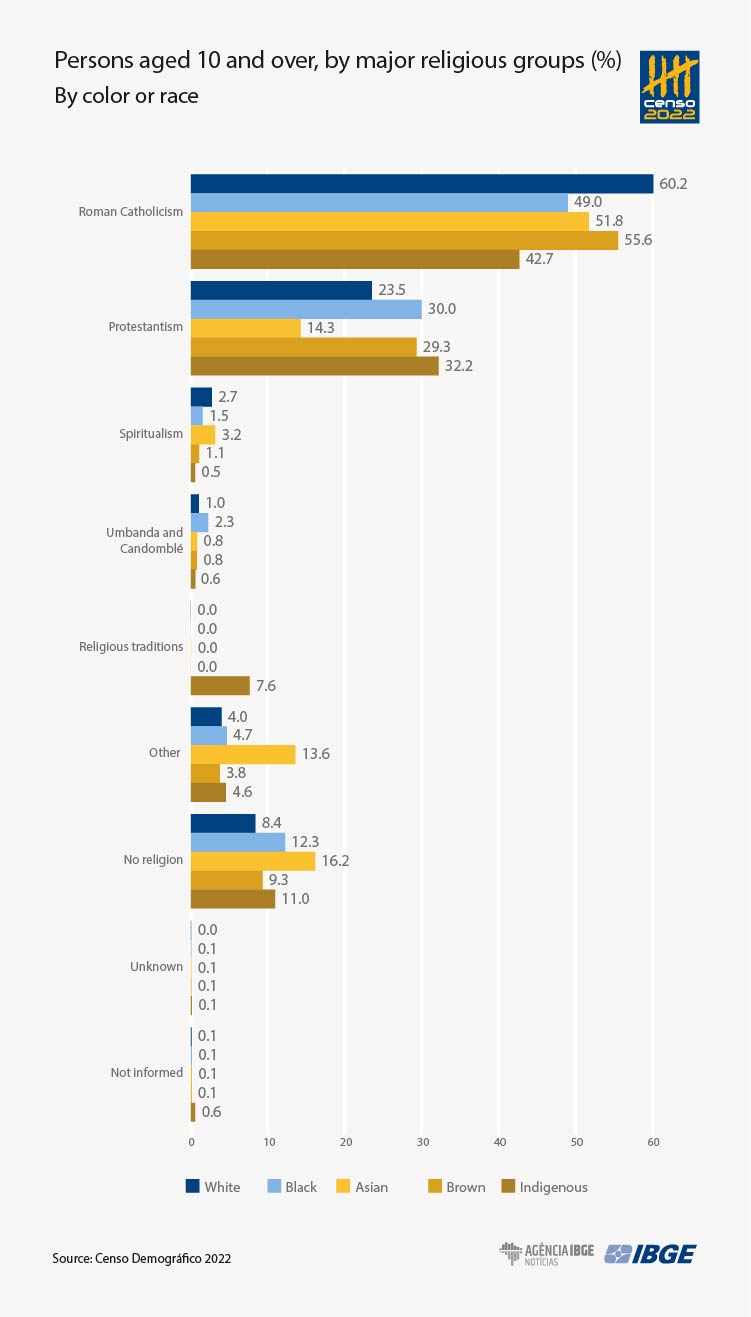
As for the distribution of each religious group by color or race, its was observed that Spiritists had a majority of white persons (63.8%) and brown ones (26.3%). Among Protestants, the majority wee brown (49.1%) and only 0.2% were Asians. Among Umbanda and Candomble practitioners, the biggest ércentages were white (42.7%) and brown (26.3%). As for followers of Indigenous traditions, 74.5% were Indigenous persons. And persons with no religion had a highest percentage of brown persons (45.1%) and white ones (39.2%).
Spiritists have the best schooling levels
Among persons aged 25 and over, Spiritistis had the lowest percentages of persons without schooling and with incomplete primary school (11.3%). It is also the group with the highest percentage of complete higher education (48.0%), a difference of 29.6 p.p. against the national overall (18.4%). Among Roman Catholics, 38.0% had no schooling or incomplete primary education and only 18.0% had a higher education degree. Followers of Indigenous traditions have the highest percentages of persons without schooling and with incomplete primary education (53.6%), a difference of 18.4 p.p. in relation to the total in Brazil (35,6%) for the same level. Among Protestants, the highest proportion has a secondary education degree and incomplete higher education, with 35.2%, followed by persons wtihout schooling and with incomplete primary education, with 34.9%.

Spiritists also held the lowest illiteracy rates among persons aged 15 and over, with 1.0%, followed by Umbanda/Candomble practitioners (2.5%) and followers of other religions (3.0%). The highest illiteracy rates were those of Indigenous traditions (24.6%) and Roman Catholics (7.8%), both above the national index (7.0%). “As for Catholics, this result is related to the aforementioned older age profile in this group. As for Indigenous traditions, considering that 74.5% of this group is formed by Indigenous persons, among wjos, in genersl, the illiteracy rate is higher,” says the analyst Bruno Mandelli Perez.
2022 Census presents new information on Indigenous traditions
In this edition, the Census improved the collection of answers on religion in Indigenous lands or Inddigenous settlements. While the general population answered the question: “What is your religion or cult?”, in Indigennous Lands and in Enumeration Areas of Indigenous settlements, the question was “What is your belief, Indigenous ritual or religion?”
This adaptation was eleborated for a better understanding of this specific population group, as explained by Marta Antunes, coordinator of Census of Traditional Peoples and Communities at the IBGE. “The different expressions of Indigenous religion were classified into complex rituals organized by ethnicity of people, thus allowing a more detailed record of Indigenous beliefs and rituals.” The record includes rituals of dances anf body painting for specific ritual moments, as well as rituals related to a people, such as the Yrerua, among the Uru Eu Wau Wau, says Marta.
Additional details about this composition will be approached in the release of final sample results for Indigenous persons, expected to be released in the second semester of 2025.
More about the survey
The release of the 2022 Population Census: Religions: Preliminary sample results presents the religious profile of the resident population in Brazil, based on information from the 2022 Population Census Sample Questionnaire. The results are available for Brazil, Major Regions, Federation Units and municipalities, disaggregated by color or race, sex and age groups of residents, literacy, level of schooling and characteristics of residents.
Data can also be found on the 2022 Census Overview and on Sidra.



